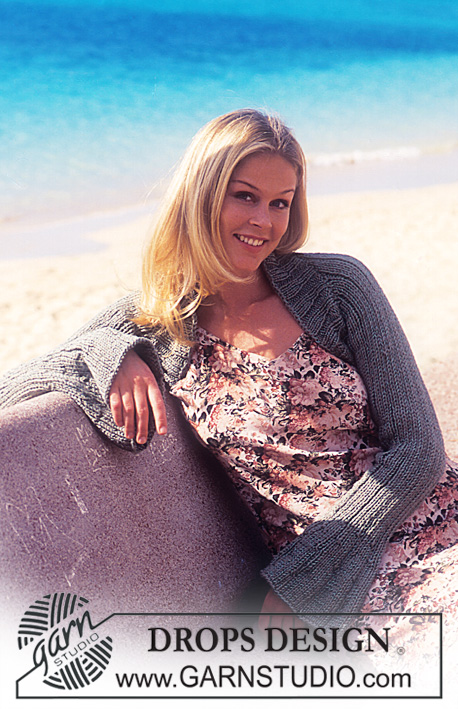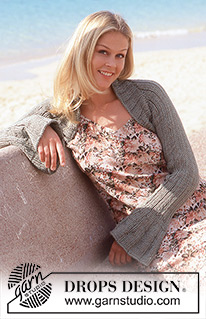Comments / Questions (9)
![]() Helinä wrote:
Helinä wrote:
Vinkki: hihoista saa keskenään samanlaiset kun neuloo kummankin erikseen ranteesta alkaen ja yhdistää selkäosassa silmukoimalla. Jos keskellä selkää vaihtaa vielä joustinneuleesta sikeäksi, silmukointisaumasta saa täysin huomaamattoman.
20.04.2019 - 08:06
![]() Helinä wrote:
Helinä wrote:
Itse itselleni vastaten, tarkemmin lukien toinen hiha neulotaan siis ranteesta olkapäähän ja toinen olkapäästä ranteeseen. Tuossa on vain se ongelma, että hihoista tulee eri näköiset, kun silmukat ja levennykset & kavennukset ovat eri suuntaan! Noin isolla langalla se kyllä näkyy :/
15.04.2019 - 06:56
![]() Helinä wrote:
Helinä wrote:
Missä kohtaa hihat liitetään toisiinsa?
14.04.2019 - 12:45DROPS Design answered:
Hei, koko työ neulotaan yhtenä kappaleena. Eli kun olet neulonut keskelle taakse asti, toinen puolikas neulotaan heti peilikuvana.
30.04.2019 - 17:39Paterson wrote:
When is the 4.5mm needle used? Pattern says to use "larger circular needle" to pick up around neck, should this read "smaller circular needle" ?
17.10.2017 - 18:39DROPS Design answered:
Dear Mrs Paterson, you will pick up stitches around whole opening of shrug with the needle size 4,5 mm - pattern will be edited asap. Thank you. Happy knitting!
18.10.2017 - 08:46
![]() Angélique Wenell wrote:
Angélique Wenell wrote:
Detta är en favorit, har nu stickat min tredje med besvär då jag får öka 2 storlekar. Den här gången virkade jag solfjäderkant runt i neonrosa blev effektfullt. mvh Angélique
17.01.2016 - 15:48
![]() July wrote:
July wrote:
Kann mir jemand sagen wie das zusammennähen am ende funktioniert? Wenn ich die maschen auf der rundstricknadel nr. 4,5 aufnehme sind die maschen doch nicht am bolero... Vielen dank schon im vorraus
03.02.2013 - 14:30DROPS Design answered:
Liebe July, die Maschen werden mit der Rundnadel rund um das Strickstück (aus der Kante) aufgenommen. Es steht „rund um den Hals aufnehmen“, das werden wir etwas umformulieren.
06.02.2013 - 10:03
![]() Catmouse wrote:
Catmouse wrote:
Danke, ich versuchs noch mal ;)
18.05.2011 - 07:30
![]() DROPS Deutsch wrote:
DROPS Deutsch wrote:
Am Rechten Teil ist "vorne" = rechte Seite und "hinten" = linke Seite der Arbeit.
05.05.2011 - 10:18
![]() Catmouse wrote:
Catmouse wrote:
Hi, ich komme mit der Anleitung nicht so ganz klar: Ab den Zu- und Abnahmen "gegen vorne" und "gegen hinten" komme ich irgendwie nicht weiter, ich weiss nicht rechts oder links zunehmen, von der Vorderseite aus gesehen. Kann vielleicht jemand helfen? Wäre schade, wenn ich nicht weiterstricken könnte, die Jacke sieht einfach toll aus. Danke.
05.05.2011 - 05:27
Evening Enchantment#eveningenchantmentbolero |
|
|
|
|
DROPS Trumpet-sleeved Shrug in Paris and Cotton Viscose
DROPS 64-22 |
|
|
Gauge: 15 sts x 22 rows on larger needles in stockinette st = 10 x 10 cm [4" x 4"]. Rib-1: * K 3, P 1 *, repeat from * - *. Rib-2: * K 6, P 1 *, repeat from * - *. Right side: Cast on 63-70-77 sts on double pointed needles with 1 strand Paris + 1 strand Cotton Viscose (= 2 strands); join and place a marker at the join. Knit Rib-2. When the work measures 5 cm [2"], dec 9-10-11 sts evenly distributed on the row as follows: * K 4, K 2 tog, P 1 * , repeat from * - * for the rest of the row = 54-60-66 sts. When the work measures 10 cm [4"], dec 9-10-11 sts evenly distributed on the row as follows: * slip 1, K 1, pass the slipped st over (psso), K 3, P 1 * , repeat from * - * for the rest of the row = 45-50-55 sts. When the work measures 15 cm [5-⅞"], dec 9-10-11 sts evenly distributed on the row as follows: * K 2, K 2 tog, P 1 * , repeat from * - * for the rest of the row = 36-40-44 sts. Knit Rib-1. When the work measures 18-18-18 cm [7"], inc 1 st each side of marker (inside of 1 purl st) 10-10-10 times every 3.5-3.5-3.5 cm [1-⅜"] = 56-60-64 sts. Knit the increased sts into Rib-1 as you go along. When the work measures 54-53-54 cm [21.25" - 20-⅞" - 21.25"], divide it in the center and knit the rest back and forth -- measure the work from here. After dividing, bind off on the right side of the work (= the front); and at the same time, inc on the left side of the work (= the back). Bind off every other row on the right side: 2 sts 5-6-6 times, then dec 1 st 14-14-16 times, and inc 1 st every other row on the left side 10-12-12 times - the increased sts are knit into Rib-1 as you go along. After all decs at the front and incs at the back are complete, 42-46-48 sts remain on the needles. When the work measures 18-20-20 cm [7" - 7-⅞" - 7-⅞"], put 8 sts on a st holder from the lower edge of the back up toward the back of the neck every other row 4 times = 10-14-16 sts remain on the needles. The shrug has now been knit to the center of the back (halfway); now knit the other half with opposite decreasing and increasing as follows: after the last 8 sts have been put on the st holder, work 1 row before putting 8 sts on the st holder back on the needles every row 4 times = 42-46-48 sts on the needles. When the work measures 29-30-31 cm [11-⅜" - 11.75" - 12.25"], from the dividing underneath the sleeve and up to the back of the neck (where sts have not been put on a st holder) inc 1 st every other row on the right side/front 14-14-16 times, then 2 sts 5-6-6 times. At the same time, after 9-8-10 incs on the right side/front, dec 1 st every other row on the left side/back 10-12-12 times. After all incs at the front and decs at the back are complete, 56-60-64 sts remain on the needles. Change to double pointed needles; join and place a marker at the join. Measure the work from here. At the same time, when the work measures 3.5 cm [1-⅜"] (from the marker), dec 1 st each side of marker at each side of 1 purl st 10-10-10 times every 3.5-3.5-3.5 cm [1-⅜"] = 36-40-44 sts. When the work measures 39-38-39 cm [15.25" - 14-⅞" - 15.25"], inc 9-10-11 sts evenly distributed on the row as follows: * K 2, K 2 sts into the next st, P 1 *, repeat from * - * for the rest of the row = 45-50-55 sts. When the work measures 45 cm [17.75"], inc 9-10-11 sts evenly distributed on the row as follows: * K 2 sts into the next st, K 3, P 1 *, repeat from * - * for the rest of the row = 54-60-66 sts. When the work measures 50 cm [19.75"], inc 9-10-11 sts evenly distributed on the row as follows: K 4, K 2 sts into the next st, P 1 *, repeat from * - * for the rest of the row = 63-70-77 sts. Continue by knitting Rib-2 until the work measures 54-53-54 cm [21.25" - 20-⅞" - 21.25"], bind off. Assembly: Pick up approx. 140-156 sts (divisible by 4) around neck/sleeve-opening on smaller circular needles with 1 strand Paris and 1 strand Cotton Viscose. Purl 1 row; continue with K 2, P 2. When the edge measures 4 cm [1.5"], inc on the next row as follows: * K 1, K 2 sts into the next st, P 2 *, repeat from * - *. Bind off when the edge measures 8 cm [3-⅛"]. |
|

|
|
Have you finished this pattern?Tag your pictures with #dropspattern #eveningenchantmentbolero or submit them to the #dropsfan gallery. Do you need help with this pattern?You'll find 25 tutorial videos, a Comments/Questions area and more by visiting the pattern on garnstudio.com. © 1982-2025 DROPS Design A/S. We reserve all rights. This document, including all its sub-sections, has copyrights. Read more about what you can do with our patterns at the bottom of each pattern on our site. |


































































Post a comment to pattern DROPS 64-22
We would love to hear what you have to say about this pattern!
If you want to leave a question, please make sure you select the correct category in the form below, to speed up the answering process. Required fields are marked *.